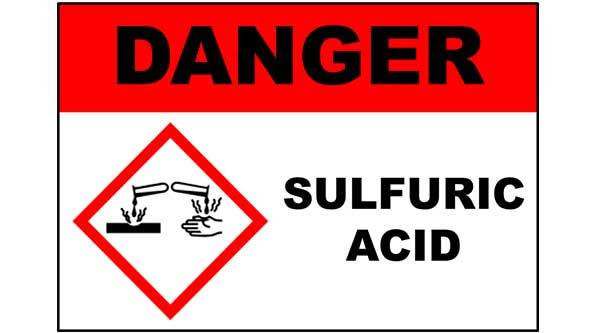Where and How Sulfuric Acid Can Be Found
Sulfuric acid is one of the most hazardous and common chemicals you may encounter. It’s actually an international commodity chemical produced in large quantities all around the world. While sulfuric acid has primarily industrial uses, it’s also found in common household products such as drain cleaner and fertilizer. Here are some important facts about sulfuric acid safety to help you be prepared when using this chemical, whether you’re in the workplace or around the home.
Sulfuric Acid and its Uses
Sulfuric acid is a clear, colorless and odorless liquid. It is water-soluble and capable of causing serious damage, especially when at high-concentration levels. Historically known as oil of vitriol, sulfuric acid began to be produced on a large scale in the 18th century.
Sulfuric acid is used for a wide range of purposes, both industrially and domestically. Produced primarily in Asia and North America, sulfuric acid is used in the production of:
- Fertilizers
- Drain cleaners
- Detergents
- Synthetic resins
- Pharmaceuticals
- Petroleum catalysts
- Insecticides
- Antifreeze
- Batteries
- Pigments such as paint, enamels, and printing inks
The Extreme Health Hazards Associated with Sulfuric Acid
Concentrated sulfuric acid is extremely corrosive and can cause serious burns when not handled properly. This chemical is unique because it not only causes chemical burns, but also secondary thermal burns as a result of dehydration. This dangerous chemical is capable of corroding skin, paper, metals, and even stone in some cases. If sulfuric acid makes direct contact with the eyes, it can cause permanent blindness. If ingested, this chemical may cause internal burns, irreversible organ damage, and possibly death.
Exposure to sulfuric acid aerosols at high concentrations leads to severe eye and respiratory tract irritation and tissue damage. Consistent exposure to sulfuric acid aerosols, even at low concentrations, can cause a person’s teeth to erode. In laboratory or industrial settings, it’s ABSOLUTELY VITAL to use proper PPE when handling sulfuric acid.
At home, you are most likely to encounter concentrated amounts of sulfuric acid when using heavy duty cleaning products such as drain cleaners. Always follow the safety instructions on the drain cleaner label to avoid these serious hazards (possibly life-threatening) risks.
How to Handle Sulfuric Acid Safely
When handling sulfuric acid in a laboratory or industrial setting, or when using products that contain concentrated sulfuric acid, it’s important to prioritize safety precautions. The following protective equipment should be worn when using sulfuric acid:
- Respirators
- Long rubber gloves
- Boots
- Industrial aprons
- Chemical safety goggles
- Face shields
If using sulfuric acid containing compounds in the workplace, access to an eye-flush station is likely required. Another important consideration when handling sulfuric acid is that it can react violently if it comes into contact with water.
First Aid Care for Sulfuric Acid Exposure
Exposure to sulfuric acid can occur as skin/bodily contact, ingestion, or inhalation of vapors. Each type of exposure can pose serious hazards to your health and should be managed immediately and appropriately by a medical professional to minimize damage and health risks.
Skin Contact – If sulfuric acid comes into contact with your skin, immediately flush the affected area gently with lukewarm water for at least 30 uninterrupted minutes. Seek medical attention immediately.
Eye Contact – If sulfuric acid gets into your eyes, immediately flush the eye(s) with water for at least 30 minutes. Seek medical attention immediately.
Ingestion – If you ingest sulfuric acid, rinse your mouth immediately with water. Do not induce vomiting. Continually rinse your mouth with water and seek medical attention as soon as possible.
Inhalation – If you inhale sulfuric acid aerosols, seek fresh air and medical attention immediately.
Proper Sulfuric Acid Storage and Disposal
Sulfuric acid or products that contain concentrated sulfuric acid should be stored in a cool, dry area away from direct sunlight and heat sources. Sulfuric acid should not be stored indoors in large quantities, to prevent the possible accumulation of vapors. Product containers should be regularly examined by professional MSDS experts for signs of damage or leaks.
Whether you’re cleaning your drains at home or working with any concentration of this chemical at work, proper sulfuric acid safety is extremely important. For more information about sulfuric acid, safety, and disposal, search our database of SDS information.
VelocityEHS Can Help!
Looking for calcium chloride hazard and safety information? Visit our VelocityEHS SDS Search page to quickly access safety data sheets (SDS) for the chemicals in your workplace. While you’re there, check out the Chemical Management capabilities of our Safety Solution, part of the VelocityEHS Accelerate® Platform. Our Chemical Management software capabilities will help you simplify the management of hazardous chemicals in your workplace including employee right-to-know access to SDSs from any mobile device, detailed workplace chemical inventory tracking, container labeling, and OSHA/EPA regulatory reporting, and much more!
Request a Demo today to see how easy GHS/HazCom compliance can be!
